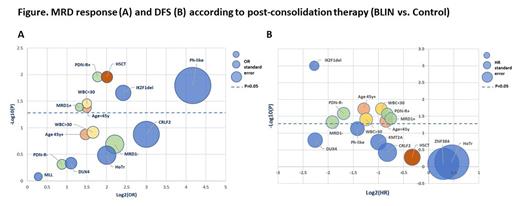Introduction. Adults with Philadelphia (Ph)-negative B-cell precursor acute lymphoblastic leukemia (BCP-ALL) benefit from blinatumomab (BLIN) in first-line consolidation. However, the magnitude of this benefit according to baseline patient and disease characteristics remains largely unexplored. In the GRAALL-2014/B QUEST sub-study, patients with high-risk (HR) features (i.e. post-induction MRD1 ≥10 -4, IKZF1 intragenic deletion, or KMT2A rearrangement) received BLIN during consolidation. Patients eligible to receive an allogeneic hematopoietic stem cell transplant (allo-HSCT) in first complete remission (CR) (i.e. those with late CR, or post-induction MRD1 ≥10 -3, or post-consolidation MRD2 ≥10 -4) received only one BLIN cycle before transplant. A control cohort was established from patients enrolled in the same protocol who exhibited the same HR criteria but did not receive BLIN in first CR. The objective of this analysis was to identify patient- and disease-related factors associated with response to BLIN, and to understand how BLIN influences the outcome after allo-HSCT.
Method. Between December 2015 and December 2020, the GRAALL-2014/B trial included 489 patients with Ph-negative BCP-ALL. Among these patients, 266 presented with HR features as defined above and 95 (including 94 evaluable patients) were included in QUEST between October 2018 and December 2020. A control group of 104 patients treated in the same trial, meeting the QUEST eligibility criteria, but not included in QUEST and not exposed to BLIN in CR1 was defined. Results have been presented last year (Boissel et al. ASH Meeting 2022). Here, we investigated which factors were associated with the benefit of BLIN in terms of MRD3 response (1 st post-BLIN MRD) and disease-free-survival (DFS). The most frequently observed genetic entities were included in the analysis (Ph-like, KMT2A-r, low hypodiploidy/near triploidy [HoTr], DUX4-r, ZNF384-r).
Results. Patients from the QUEST cohort had a higher chance to be MRD3-negative (<10 -4) when compared to the control cohort (OR, 2.8; 95%CI, 1.3-6.2; p=0.011). Among them, younger patients (<45y), patients with WBC<30 G/L, with poor prednisone response, with IKZF1 deletion or with Ph-like disease had a significantly higher chance to be MRD3-negative after BLIN than after chemotherapy. Among genetic entities, ORs ranged from 1.2 for KMT2A-r to 5.3 for Ph-like BCP-ALL (Figure A). Due to a reduced risk of relapse, patients had a significantly prolonged DFS after BLIN (HR, 0.49; 95%CI, 0.31-0.78; p=0.002), whatever their age (< vs ≥45y), WBC at diagnosis (< vs ≥30 G/L), prednisone response, and MRD1 (<10 -4vs ≥10 -4) (Figure B). Among genetic entities, HR for DFS ranged from 0.21 for DUX4-r to 1.38 for HoTr with none of these differences that reached significance. Patients with IKZF1 deletion had the most significant benefit from BLIN on DFS (HR, 0.21; 95%CI, 0.08-0.52; p=0.001) with a significant interaction between IKZF1 status and the use of BLIN (p=0.011). Patients who received allo-HSCT had a higher chance to be MRD negative before transplant when treated with BLIN (OR, 4.0; 95%CI, 1.4-11.7; p=0.011), however this did not translate into a longer DFS (HR, 0.79; 95%CI, 0.39-1.60). In addition, prior transplant MRD level had a higher impact on post-transplant DFS in the patients exposed to BLIN (HR, 0.28; 95%CI, 0.10-0.79; p=0.017) than in those treated with chemotherapy (HR, 0.74; 95%CI, 0.24-2.27; p=0.60).
Conclusion. In adult patients with Ph-negative BCP-ALL who experience an overall benefit of BLIN in consolidation, the present study reveals a heterogeneous landscape of response among genetic entities. Larger prospective studies should further explore this heterogeneity to refine implementation of BLIN in frontline setting.
OffLabel Disclosure:
Boissel:Astellas Pharma: Honoraria; Servier: Consultancy, Honoraria, Other: Advisory role; Amgen: Consultancy, Honoraria, Other: Expert Testimony and advisory role, Research Funding; Novartis: Consultancy, Honoraria, Other: Advisory role, Research Funding; ARIAD/Incyte: Honoraria. Huguet:NOVARTIS: Honoraria; PFIZER: Honoraria; INCYTE: Honoraria. Chevallier:Sanofi: Honoraria; Mallinckrodt Pharmaceuticals: Honoraria; Incyte: Honoraria, Research Funding; Takeda: Honoraria; Immedica Pharma: Honoraria; Servier: Honoraria. Cluzeau:Syros: Speakers Bureau; Jazz Pharma: Consultancy, Speakers Bureau; Incyte: Speakers Bureau; Servier: Consultancy, Speakers Bureau; Abbvie: Consultancy, Speakers Bureau; Novartis: Consultancy, Speakers Bureau; BMS: Consultancy, Speakers Bureau; Keros: Speakers Bureau. Chalandon:MSD: Honoraria, Other: travel support; Novartis: Honoraria, Other: travel support; Incyte: Honoraria, Other: travel support; Janssen: Other: travel support; BMS: Honoraria, Other: travel support; Pfizer: Honoraria; Abbvie: Honoraria, Other: travel support; Sanofi: Other: travel support; Roche: Honoraria, Other: travel support; Jazz: Honoraria, Other: travel support, Speakers Bureau; Gilead: Honoraria, Other: travel support; Amgen: Honoraria, Other: travel support; Astra-Zeneca: Honoraria, Other: travel support; Servier: Honoraria. Dombret:Astellas: Research Funding; Pfizer: Research Funding; Servier: Membership on an entity's Board of Directors or advisory committees, Research Funding; Incyte: Membership on an entity's Board of Directors or advisory committees; Jazz Pharmaceuticals: Membership on an entity's Board of Directors or advisory committees, Research Funding.
Blinatumomab frontline for high-risk B-ALL


This feature is available to Subscribers Only
Sign In or Create an Account Close Modal